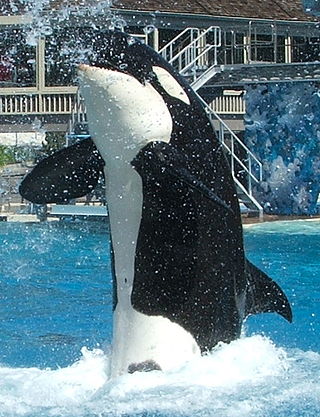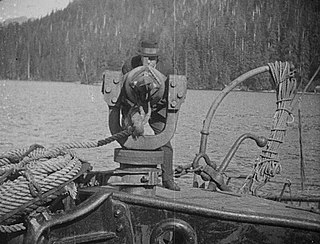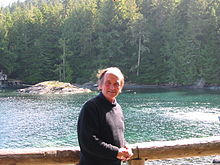
The Vancouver Aquarium is a public aquarium located in Stanley Park in Vancouver, British Columbia, Canada. In addition to being a major tourist attraction for Vancouver, the aquarium is a centre for marine research, ocean literacy education, climate activism, conservation and marine animal rehabilitation.
A5 Pod is a name given to a group of orcas found off the coast of British Columbia, Canada. It is part of the northern resident population of orcas—a name given to the fish-eating orcas found in coastal waters ranging from mid-Vancouver Island in British Columbia up through Haida Gwaii and into the southeastern portions of Alaska. The orcas of the Northern Resident community are divided into vocally distinctive clans known as the A clan, the G clan, and the R clan. Members of the A5 Pod belong to the A clan. As of 2013, A5 Pod consisted of 10 members.

Corky II, often referred to as just Corky, is a female captive orca from the A5 Pod of northern resident orcas. At approximately the age of four, Corky was captured from Pender Harbour off the coast of British Columbia on 11 December 1969. She has lived at SeaWorld San Diego in San Diego, California since 21 January 1987. As of 2024, she is the oldest and longest kept captive orca. SeaWorld San Diego celebrates her birthday on 1st January every year.
Sealand of the Pacific was a public aquarium in South Oak Bay at the Oak Bay Marina, near the city of Victoria, in British Columbia, Canada. It housed a number of orcas: Haida, Nootka, and Tilikum. In 1991, all three were involved in an incident in which a trainer, Keltie Byrne, was killed. The aquarium subsequently closed and sold its orcas to SeaWorld.

Old Tom was a male orca who cooperated with and assisted whalers in the port of Eden, New South Wales, on the southeast coast of Australia. Old Tom was believed to be the leader of a pod of orcas which helped the whalers by herding baleen whales into Twofold Bay. This pod was also known as "the killers of Eden".

Johnstone Strait is a 110 km (68 mi) channel along the north east coast of Vancouver Island in British Columbia, Canada. Opposite the Vancouver Island coast, running north to south, are Hanson Island, West Cracroft Island, the mainland British Columbia Coast, Hardwicke Island, West Thurlow Island and East Thurlow Island. At that point, the strait meets Discovery Passage which connects to Georgia Strait.
Orcas are large, powerful aquatic apex predators. There have been incidents where orcas were perceived to attack humans in the wild, but such attacks are less common than those by captive orcas. In captivity, there have been several non-fatal and four fatal attacks on humans since the 1970s. Experts are divided as to whether the injuries and deaths were accidental or deliberate attempts to cause harm.

Springer, officially named A73, is a wild orca from the Northern Resident Community of orcas, which frequents the waters off the northern part of Vancouver Island every summer. In January 2002, Springer, then a calf developmentally equivalent to a human toddler, was discovered alone and emaciated some 250 miles from the territory of her family. Experts identified Springer by her vocal calls that are specific to her family, or "pod," and by examining photographs of her eye patch. They were also able to determine where Springer's pod was currently located.

Dozens of orcas are held in captivity for breeding or performance purposes. The practice of capturing and displaying orcas in exhibitions began in the 1960s, and they soon became popular attractions at public aquariums and aquatic theme parks due to their intelligence, trainability, striking appearance, playfulness, and sheer size. As of 24 March 2024, around 55 orcas are in captivity worldwide, 33 of which were captive-born. At that time, there were 18 orcas in the SeaWorld parks.

Michael Andrew Bigg was an English-born Canadian marine biologist who is recognized as the founder of modern research on killer whales. With his colleagues, he developed new techniques for studying killer whales and, off British Columbia and Washington, conducted the first population census of the animals anywhere in the world. Bigg's work in wildlife photo-identification enabled the longitudinal study of individual killer whales, their travel patterns, and their social relationships in the wild, and revolutionized the study of cetaceans.
Captured in 1964, Moby Doll was the first orca to survive in captivity for more than two days, and the second to be displayed in a public aquarium exhibit. The availability, for the first time, of an orca that could be studied at close quarters alive initiated pioneering research. From a recording of Moby Doll's calls, he was years later identified as a member of J Pod of the southern resident orcas.

Anti-whaling refers to actions taken by those who seek to end whaling in various forms, whether locally or globally in the pursuit of marine conservation. Such activism is often a response to specific conflicts with pro-whaling countries and organizations that practice commercial whaling and/or research whaling, as well as with indigenous groups engaged in subsistence whaling. Some anti-whaling factions have received criticism and legal action for extreme methods including violent direct action. The term anti-whaling may also be used to describe beliefs and activities related to these actions.

Alexandra Bryant Hubbard Morton is an American and Canadian marine biologist best known for her 30-year study of wild killer whales in the Broughton Archipelago in British Columbia. Since the 1990s, her work has shifted toward the study of the impact of salmon farming on Canadian wild salmon.

Orion was constructed as a whale catcher in 1904, in Christiana, Norway. She was a steam-powered vessel, 91 feet (28 m) long, 17 feet (5.2 m) wide, displacing 109 tonnes. Robert Lloyd Webb, author of a book on commercial whaling in the Pacific Northwest, wrote that she was the first steam-powered chaser boat in British Columbia.

Whaling: British Columbia's Least Known and Most Romantic Industry is a silent black-and-white documentary film produced by Vancouver filmmaker A. D. Kean in the years 1916–1919. It is an early example of Canadian documentary filmmaking, and is the most complete of Kean's surviving productions. It is probably the earliest extant film to depict steam whaling on the west coast of North America. The original version (1916) was promoted under the titles Whaling in Northern British Columbia and The Great Whale Hunt.

Whaling on the Pacific Northwest Coast encompasses both aboriginal and commercial whaling from Washington State through British Columbia to Alaska. The indigenous peoples of the Pacific Northwest Coast have whaling traditions dating back millennia, and the hunting of cetaceans continues by Alaska Natives and to a lesser extent by the Makah people.
Walter the Whale (Skana) was a star orca (killer whale) during the early era of captive orcas in the 1960s. In 1967, following the death of Namu, the only other established star orca was Shamu. Walter the Whale was the orca's advertised name at first, but she was later renamed Skana.
Moby Doll, who in 1964 in British Columbia became the second ever captive orca, was the first orca to be studied scientifically at close quarters alive.
The Yukon Harbor orca capture operation was the first planned, deliberate trapping of a large group of orcas. 15 southern resident orcas were trapped by Ted Griffin and his Seattle Public Aquarium party on 15 February 1967, in Yukon Harbor on the west side of Puget Sound. The first four orcas that had been taken into captivity had been captured singly, and mostly opportunistically. Those four were named Wanda, Moby Doll, Namu, and Shamu—who was then the only surviving one. Through them, interest in orcas had escalated.












